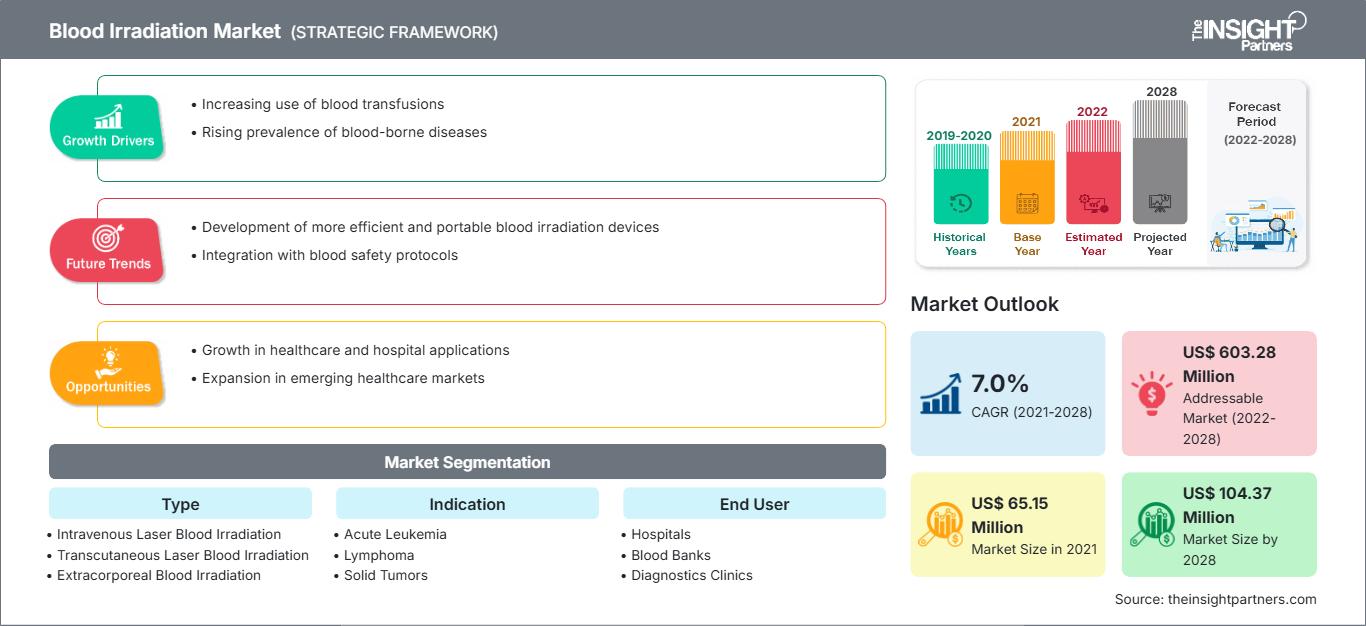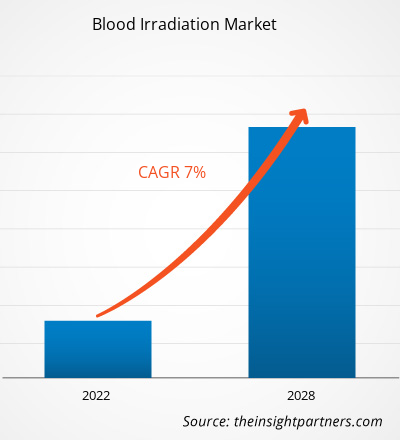Si prevede che il mercato dell'irradiazione del sangue raggiungerà i 104,37 milioni di dollari entro il 2028, rispetto ai 65,15 milioni di dollari del 2021; si prevede una crescita a un CAGR del 7,0% dal 2022 al 2028.
La crescente prevalenza di malattie trasmissibili e non trasmissibili e l'incremento della ricerca e sviluppo guidano la crescita del mercato. Tuttavia, l'elevato costo dell'irradiazione del sangue ne limita la crescita.
L'irradiazione del sangue si ottiene esponendo il sangue ad almeno 25 Gy (2500 cGy) di radiazioni al centro del vaso, impedendo la replicazione e l'attecchimento dei leucociti T del donatore immunologicamente competenti nel ricevente. La GVHD causata da trapianti da donatori è quasi sempre fatale, quindi i pazienti a rischio dovrebbero ricevere emoderivati irradiati, se il tempo e le risorse lo consentono. Indicazioni cliniche, tra cui leucemia acuta, linfoma, tumori solidi sottoposti a chemioterapia o radioterapia intensiva, exsanguinotrasfusioni, pazienti sottoposti a trapianto di organi e neonati prematuri, richiedono la radioterapia con emoderivati. I pazienti affetti da virus dell'immunodeficienza umana/sindrome da immunodeficienza acquisita non necessitano di irradiazione con emoderivati, in quanto non sono stati segnalati casi di suscettibilità alla malattia del trapianto all'ospite post-trasfusionale.
Personalizza questo rapporto in base alle tue esigenze
Potrai personalizzare gratuitamente qualsiasi rapporto, comprese parti di questo rapporto, o analisi a livello di paese, pacchetto dati Excel, oltre a usufruire di grandi offerte e sconti per start-up e università
Mercato dell'irradiazione del sangue: Approfondimenti strategici

-
Ottieni le principali tendenze chiave del mercato di questo rapporto.Questo campione GRATUITO includerà l'analisi dei dati, che vanno dalle tendenze di mercato alle stime e alle previsioni.
Approfondimenti di mercato
L'aumento della prevalenza di malattie trasmissibili e non trasmissibili stimola la crescita del mercato
Si registra un aumento dell'incidenza di malattie trasmissibili e non trasmissibili, tra cui cancro, disturbi cardiovascolari, malattie renali croniche e ictus, a causa dell'ampia popolazione mondiale suscettibile a tali patologie. Secondo l'Organizzazione Mondiale della Sanità (OMS), i disturbi cardiovascolari sono la principale causa di morte a livello globale e ogni anno si registrano circa 17,9 milioni di decessi. Inoltre, la crescente prevalenza di malattie trasmissibili, come epatite, influenza, virus dell'immunodeficienza umana (HIV) e sindrome da immunodeficienza acquisita (AIDS), sta trainando la crescita del mercato dell'irradiazione del sangue. Secondo l'OMS, nel 2020 325 milioni di persone sono state infettate dal virus dell'epatite B e 900.000 persone muoiono ogni anno a causa di tale infezione. Inoltre, un'ampia popolazione geriatrica in tutto il mondo contribuisce alla prevalenza di malattie non trasmissibili, come disturbi cardiovascolari, renali e ictus. Secondo l'OMS, la popolazione di età pari o superiore a 60 anni era di 1 miliardo nel 2019 e si prevede che aumenterà a 1,4 miliardi entro il 2030 e a 2,1 miliardi entro il 2050. La popolazione anziana è suscettibile alle malattie non trasmissibili a causa di vari fattori, come una cattiva alimentazione, la mancanza di attività fisica, l'uso eccessivo di tabacco e il consumo di alcol.
Inoltre, l'aumento delle trasfusioni di sangue dovuto all'aumento di interventi chirurgici, incidenti, traumi e patologie, insieme alla crescente prevalenza di infezioni del flusso sanguigno, sostiene la crescita del mercato. Infezioni del torrente ematico, patologie preesistenti e procedure invasive sono comuni tra la popolazione geriatrica. Le infezioni del torrente ematico sono la principale causa di malattia e morte in popolazioni numerose. Secondo la National Library of Medicine, ogni anno si verificano circa 28.000 infezioni del torrente ematico in tutto il mondo. Inoltre, la crescente consapevolezza sulle infezioni del torrente ematico e l'aumento delle risposte immunitarie al sangue trasfuso possono causare complicazioni, poiché il crescente utilizzo di sangue irradiato nel trattamento del cancro rafforza il sistema immunitario e migliora la salute generale dei pazienti, il che sta guidando la crescita del mercato dell'irradiazione del sangue.
Pertanto, l'aumento della prevalenza di malattie trasmissibili e non trasmissibili, l'aumento delle trasfusioni di sangue, l'impennata delle infezioni del torrente ematico e l'aumento delle risposte immunitarie stanno guidando la crescita del mercato dell'irradiazione del sangue.
Approfondimenti basati sulla tipologia
Il mercato dell'irradiazione del sangue, in base alla tipologia, è segmentato in irradiazione del sangue laser endovenosa, irradiazione del sangue laser transcutanea e irradiazione del sangue extracorporea. Nel 2021, il segmento dell'irradiazione laser endovenosa del sangue ha rappresentato la quota di mercato maggiore. Tuttavia, si prevede che il segmento dell'irradiazione laser extracorporea del sangue registrerà il CAGR più elevato, pari al 7,8%, durante il periodo di previsione.
Approfondimenti basati sull'utente finale
In base all'utente finale, il mercato dell'irradiazione del sangue è segmentato in ospedali, banche del sangue, cliniche diagnostiche e istituti di ricerca. Il segmento ospedaliero ha detenuto la quota di mercato maggiore nel 2021. Tuttavia, si stima che il segmento delle banche del sangue registrerà il CAGR più elevato, pari al 7,7%, durante il periodo di previsione.
Approfondimenti regionali sul mercato dell'irradiazione del sangue
Le tendenze regionali e i fattori che influenzano il mercato dell'irradiazione del sangue durante il periodo di previsione sono stati ampiamente spiegati dagli analisti di The Insight Partners. Questa sezione illustra anche i segmenti e la geografia del mercato dell'irradiazione del sangue in Nord America, Europa, Asia-Pacifico, Medio Oriente e Africa, America meridionale e centrale.
Ambito del rapporto di mercato sull'irradiazione del sangue
| Attributo del rapporto | Dettagli |
|---|---|
| Dimensioni del mercato in 2021 | US$ 65.15 Million |
| Dimensioni del mercato per 2028 | US$ 104.37 Million |
| CAGR globale (2021 - 2028) | 7.0% |
| Dati storici | 2019-2020 |
| Periodo di previsione | 2022-2028 |
| Segmenti coperti |
By Tipo
|
| Regioni e paesi coperti |
Nord America
|
| Leader di mercato e profili aziendali chiave |
|
Densità degli operatori del mercato dell'irradiazione del sangue: comprendere il suo impatto sulle dinamiche aziendali
Il mercato dell'irradiazione del sangue è in rapida crescita, trainato dalla crescente domanda degli utenti finali dovuta a fattori quali l'evoluzione delle preferenze dei consumatori, i progressi tecnologici e una maggiore consapevolezza dei benefici del prodotto. Con l'aumento della domanda, le aziende stanno ampliando la propria offerta, innovando per soddisfare le esigenze dei consumatori e sfruttando le tendenze emergenti, alimentando ulteriormente la crescita del mercato.

- Ottieni il Mercato dell'irradiazione del sangue Panoramica dei principali attori chiave
Approfondimenti basati sulle indicazioni
Per indicazione, il mercato dell'irradiazione del sangue è segmentato in leucemia acuta, tumori solidi, tumori pelvici, linfoma e altri. Il segmento della leucemia acuta ha detenuto la quota di mercato maggiore nel 2021. Tuttavia, si stima che il segmento del linfoma registrerà il CAGR più elevato, pari all'8,8%, nel periodo di previsione.
Le aziende che operano nel mercato dell'irradiazione del sangue adottano una strategia di innovazione di prodotto per soddisfare le mutevoli esigenze dei clienti in tutto il mondo, il che consente loro anche di mantenere il proprio marchio sul mercato globale. Ad esempio, nel giugno 2021, Rad Source Technologies, un fornitore statunitense di prodotti per radiazioni a raggi X commerciali, ha progettato un prodotto per sostituire gli irradiatori gamma autoschermati e ha presentato il suo irradiatore ematico RS 3400 riprogettato al MEDLAB Middle East 2021.
Mercato dell'irradiazione del sangue: per area geografica
Geograficamente, il mercato dell'irradiazione del sangue è segmentato in Nord America (Stati Uniti, Canada e Messico), Europa (Francia, Germania, Regno Unito, Spagna, Italia e resto d'Europa), Asia Pacifico (Cina, India, Giappone, Australia, Corea del Sud e resto dell'Asia Pacifico), Medio Oriente e Africa (Arabia Saudita, Emirati Arabi Uniti, Sudafrica e resto del Medio Oriente e Africa) e America meridionale e centrale (Brasile, Argentina e resto dell'America meridionale e centrale). Typenex Medical, LLC; Hitachi Medical Systems; Rad Source Technologies; Gilardoni SpA; Tra i partecipanti al mercato inclusi nello studio di ricerca figurano Gamma-Service Medical GmbH, Actemium e Best Theratronics Ltd.
- Analisi storica (2 anni), anno base, previsione (7 anni) con CAGR
- Analisi PEST e SWOT
- Valore/volume delle dimensioni del mercato - Globale, Regionale, Nazionale
- Industria e panorama competitivo
- Set di dati Excel
Report recenti
Rapporti correlati
Testimonianze
Motivo dell'acquisto
- Processo decisionale informato
- Comprensione delle dinamiche di mercato
- Analisi competitiva
- Analisi dei clienti
- Previsioni di mercato
- Mitigazione del rischio
- Pianificazione strategica
- Giustificazione degli investimenti
- Identificazione dei mercati emergenti
- Miglioramento delle strategie di marketing
- Aumento dell'efficienza operativa
- Allineamento alle tendenze normative






















 Ottieni un campione gratuito per - Mercato dell'irradiazione del sangue
Ottieni un campione gratuito per - Mercato dell'irradiazione del sangue